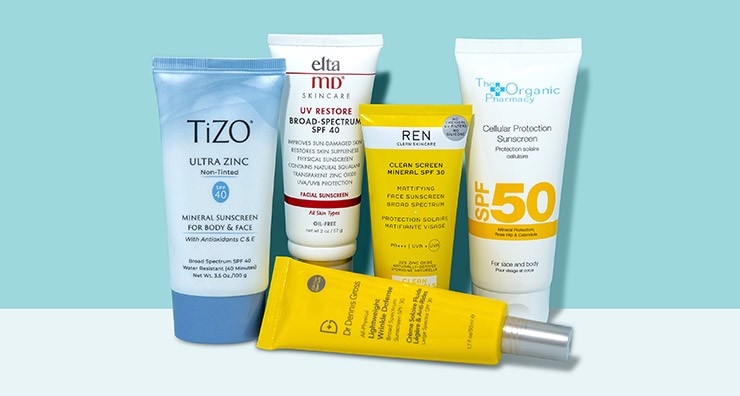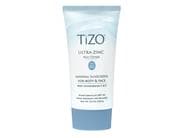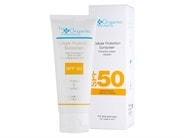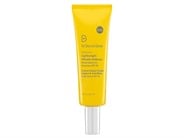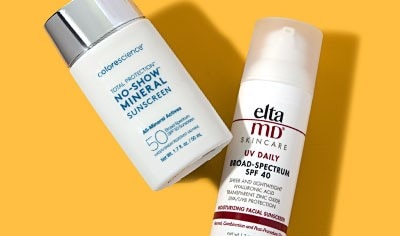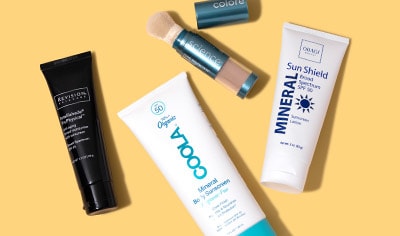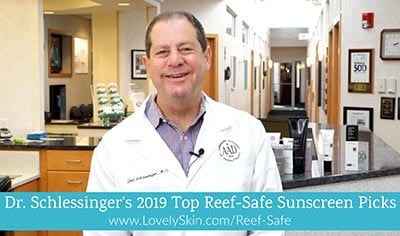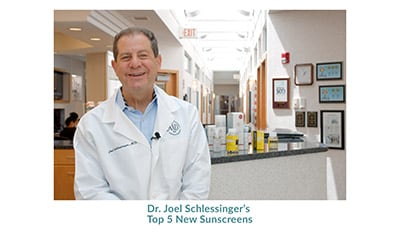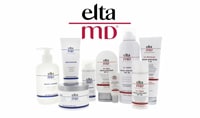If you have an ocean getaway on the books, there’s one question you need to ask yourself when stocking your beach bag with sunscreen for the day: Is my sunscreen reef-safe? Maybe you’re staying at a resort that requires the use of reef-safe sunscreen, or you’ve heard the buzz about reef-friendly sunscreens and aren’t sure what to make of it. Either way, we’re here to dig into the topic of reef-safe sunscreen and answer some of the most frequently asked questions about them with the help of board-certified dermatologist and LovelySkin CEO Dr. Joel Schlessinger, including:
Some sunscreen ingredients may have the potential to harm coral, algae, fish and other marine life, according to the National Ocean Service. These ingredients include oxybenzone, octocrylene, octinoxate, PABA, nano-titanium dioxide and nano-zinc oxide. Some popular vacation destinations, including Hawaii, have passed laws that ban the sale of sunscreens that contain some or all of these ingredients.
These laws have beachgoers on the hunt for reef-safe sunscreens or reef-friendly sunscreens. “We want our patients and customers to be safe at the beach, while also protecting the environment,” Dr. Schlessinger says. “Physical sunscreens—also called mineral sunscreens—offer protection for coral reefs while also protecting your skin.”
The terms “nano” and “non-nano” refer to the particle size of titanium dioxide and zinc oxide, two of the most popular active ingredients that give mineral sunscreens their SPF. “Nano means the particles are synthesized to be very, very small,” Dr. Schlesinger says. “Zinc oxide and titanium dioxide tend to leave a white cast on skin, so sunscreen makers have looked to nano and micronized versions of these ingredients to reduce the white cast and create formulas that are easier to rub into your skin.”
So, what’s a beach-goer to do? Check your sunscreen’s ingredient list before you pack for your ocean vacation. Sunscreens made with non-nano zinc oxide and titanium dioxide tend to be labeled as such. “Though there’s more research to be done, the latest suggests sunscreen containing non-nano zinc oxide and titanium dioxide could be the better choice for ocean swimming,” Dr. Schlessinger says.
It’s always a good idea to reapply your sunscreen according to the manufacturer’s recommendations on the packaging. “As a general rule, you should reapply sunscreen every two hours unless you are sweating or in the water, but with physical sunscreens, you will probably need to reapply more frequently if you are sweating or swimming, regardless of what the label says,” Dr. Schlessinger says. “I actually reapply my sunscreen every 30 minutes if I am active or swimming.”
Additional sun safety measures such as wearing a wide-brimmed hat and sun shirts can help supplement your sunscreen use and reduce sun exposure at the beach or otherwise. "If you have the choice of purchasing a hat or clothing that is labeled UPF (ultraviolet protection factor), it is likely going to be more protective than regular clothing,” Dr. Schlessinger says. “Studies have been done on the typical white T-shirt and it turns out that they only offer about an SPF 2. That's all!"
Headed to the shore? Here are five dermatologist-recommended sunscreens that you can feel good about packing in your beach bag this season:
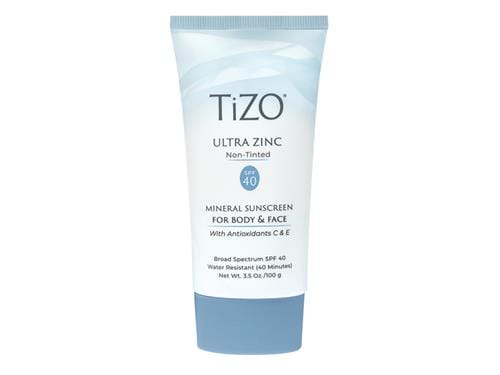
TiZO calls its sunscreens reef-friendly, and its entire sun protection line is mineral-based, non-nano and free of chemical filters, including octinoxate and oxybenzone. This sunscreen for face and body protects with 20% zinc oxide and is entirely fragrance-free, making it a great choice for beachgoers who are irritated by heavily scented sunscreens. It has a gentle formula that’s well-suited for sensitive skin and even post-procedure skin.

Looking for a no-shine face sunscreen for beach days? This mattifying sunscreen from REN is made with rice extract, so it dries to a matte finish and helps reduce the appearance of large pores. It uses non-nano zinc oxide, which is less likely to pose a threat to coral and other marine life. As an eco-friendly bonus, this sunscreen’s cap is made entirely of recycled plastic, and the tube is made with 50% recycled plastic.
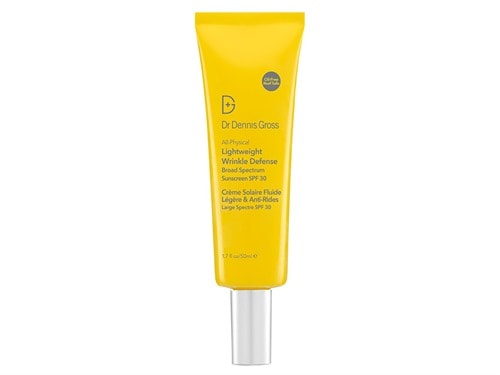
This reef-friendly sunscreen combines broad-spectrum sun protection with a multitasking formula designed to provide anti-aging skin care benefits. It protects your skin from sun damage with non-nano zinc oxide and also helps protect against signs of aging—including fine lines and wrinkles—thanks to antioxidant-packed ingredients, such as lingonberry, sea buckthorn, bearberry and ferulic acid. A touch of aloe helps keep skin hydrated too.
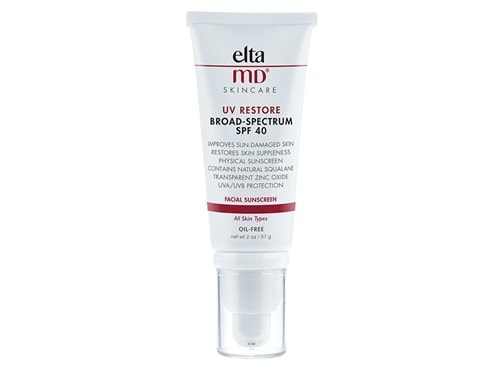
This all-mineral facial sunscreen is formulated to help restore and improve the appearance of sun-damaged skin while also offering protection from further damage. It provides broad-spectrum protection with titanium dioxide and zinc oxide and also contains a blend of skin-improving ingredients, including squalane for moisture retention and antioxidants to help brighten dark spots and smooth rough texture. Choose from two options: untinted or a light universal tint. Need a body sunscreen too? EltaMD Pure is an all-mineral formula for beach days that you can use on the whole family, including children. It goes on white and leaves a slight residue on the skin, so you can be sure you haven’t missed any spots. “Given the white residue, this sunscreen is best used on younger children,” Dr. Schlessinger says.
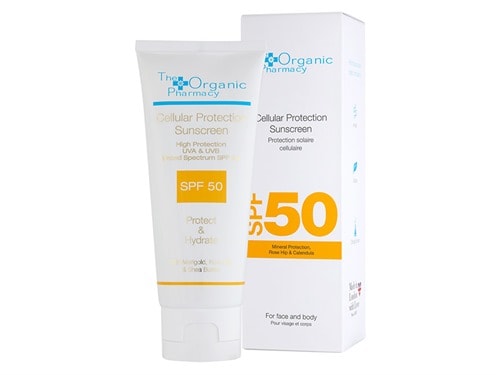
“Coral safe” is the term that The Organic Pharmacy likes to use for its sunscreens, including this mineral formula for face and body made with zinc oxide and titanium dioxide. Hydrating ingredients such as glycerin and shea butter give this sunscreen a silky texture and also make it a great choice for parched skin. If you’re a fan of organic skin care, you’ll be happy to know this formula contains a number of organic ingredients, including organic sunflower seed oil, calendula extract, shea butter and aloe.
Looking for more sunscreen recommendations? Check out our picks for the best body sunscreens for daily use.


